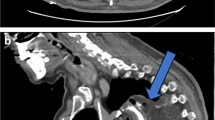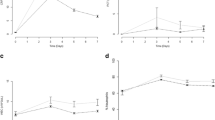Abstract
Background
The aim of the study was to assess serum C-reactive protein (CRP) level immediately after minimally invasive esophagectomy (MIE) as a surrogate of surgical invasiveness in patients who underwent esophagectomy.
Methods
In total, 104 patients were enrolled in the study: 37 patients underwent MIE in the left lateral decubitus position (MIE-LP) and 67 patients underwent MIE in the prone position (MIE-PP). Serum CRP levels were assessed on POD 1, 3, 5, and 7 after MIE, and were compared with surgical outcomes and duration of systemic inflammatory response syndrome (SIRS) to investigate less invasiveness of the MIE.
Results
Reduced serum CRP level on POD 1 was associated with PP during MIE (P < 0.001) and decreased blood loss (P = 0.03). MIE-PP was identified as a significant independent predictor of reduced CRP level on POD 1 (odds ratio 3.65, P = 0.042). CRP level on POD 7 was associated with gender (P = 0.02), position of MIE (P = 0.011), blood loss (P = 0.02), and respiratory complications and/or anastomotic leakage (P < 0.001). Postoperative respiratory and/or anastomotic complication was identified as a significant predictor of elevated serum CRP level on POD 7 (odds ratio 3.44, P = 0.048). Shorter duration of SIRS was shown in the patients with reduced serum CRP level on POD 1 and 7 (P = 0.03 and P < 0.001, respectively).
Conclusion
Serial assessments of serum CRP level immediately after MIE may be a possible indicator that can reflect surgical invasiveness and postoperative complications.

Similar content being viewed by others
References
Tachimori Y, Ozawa S, Numasaki H, et al. Comprehensive registry of esophageal cancer in Japan, 2009. Esophagus. 2016;13:110–37.
Cuschieri A, Shimi S, Banting S. Endoscopic oesophagectomy through a right thoracoscopic approach. J R Coll Surg. 1992;37:7–11.
Luketich JD, Alvelo-Rivera M, Buenaventura PO, et al. Minimally invasive esophagectomy outcome in 222 patients. Ann Surg. 2003;238:486–95.
Noshiro H, Nagai E, Shimizu S, et al. Minimally invasive radical esophagectomy for esophageal cancer. Esophagus. 2007;4:59–65.
Osugi H, Takemura M, Higashino M, et al. A comparison of video-assisted thoracoscopic oesophagectomy and radical lymph node dissection for squamous cell cancer of the oesophagus with open operation. Br J Surg. 2003;90:108–13.
Koyanagi K, Ozawa S, Tachimori Y. Minimally invasive esophagectomy performed with the patient in a prone position: a systematic review. Surg Today. 2016;46:275–84.
Matsuda S, Takeuchi H, Kawakubo H, et al. Correlation between intense postoperative inflammatory response and survival of esophageal cancer patients who underwent transthoracic esophagectomy. Ann Surg Oncol. 2012;22:4453–60.
Hoeboer SH, Groeneveld ABJ, Engels N, et al. Rising C-reactive protein and procalcitonin levels precede early complications after esophagectomy. J Gastrointest Surg. 2015;19:613–24.
Ibuki Y, Hamai Y, Hihara J, et al. Role of postoperative C-reactive protein levels in predicting prognosis after surgical treatment of esophageal cancer. World J Surg. 2017;41:1558–65.
Sobin LH, Gospodarowicz M, Wittekind C. International Union Against Cancer (UICC). In: TNM classification of malignant tumors. 7th ed. New York: Wiley; 2009.
Maas KW, Biere SSAY, van Hoogstraten IMW, et al. Immunological changes after minimally invasive or conventional esophageal resection for cancer: a randomized trial. World J Surg. 2014;38:131–7.
Chen L, Sun L, Lang Y, et al. Fast-track surgery improves postoperative clinical recovery and cellular and humoral immunity after esophagectomy for esophageal cancer. BMC Cancer. 2016;16:449.
American College of Chest Physicians/Society of Critical Care. Medicine Consensus Conference: definition for sepsis and organ failure and guidelines for the use of innovative therapies in sepsis. Crit Care Med. 1992;20:864–74.
Koyanagi K, Igaki H, Iwabu J, et al. Recurrent laryngeal nerve paralysis after esophagectomy: respiratory complications and role of nerve reconstruction. Tohoku J Exp Med. 2015;237:1–8.
Yatabe T, Kitagawa H, Yamashita K, et al. Better postoperative oxygenation in thoracoscopic esophagectomy in prone positioning. J Anesth. 2010;24:803–6.
Ozawa S, Ito E, Kazuno A, et al. Thoracoscopic esophagectomy while in a prone position for esophageal cancer: a preceding anterior approach method. Surg Endosc. 2013;27:40–7.
Author information
Authors and Affiliations
Corresponding author
Ethics declarations
Ethical Statement
This work followed the guidelines set forth in the Helsinki Declaration of 1975, as revised in 2000, concerning Human and Animal Rights. This article does not contain human or animal subjects performed by any authors. This was a retrospective study approved by the institutional review board of the National Cancer Center Hospital.
Conflict of interest
There are no financial or other relations that could lead to a conflict of interest.
Rights and permissions
About this article
Cite this article
Koyanagi, K., Ozawa, S. & Tachimori, Y. Minimally invasive esophagectomy in the prone position improves postoperative outcomes: role of C-reactive protein as an indicator of surgical invasiveness. Esophagus 15, 95–102 (2018). https://doi.org/10.1007/s10388-017-0602-8
Received:
Accepted:
Published:
Issue Date:
DOI: https://doi.org/10.1007/s10388-017-0602-8




